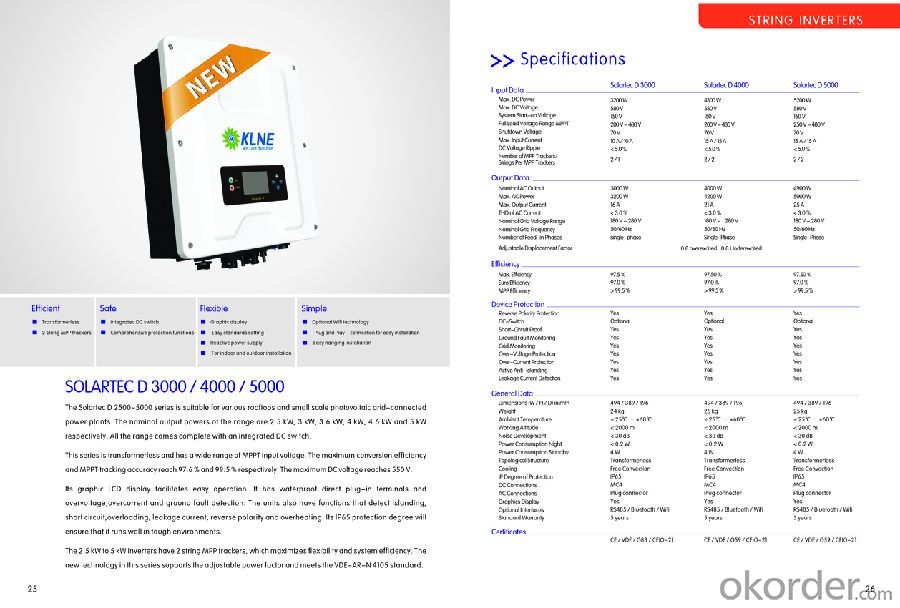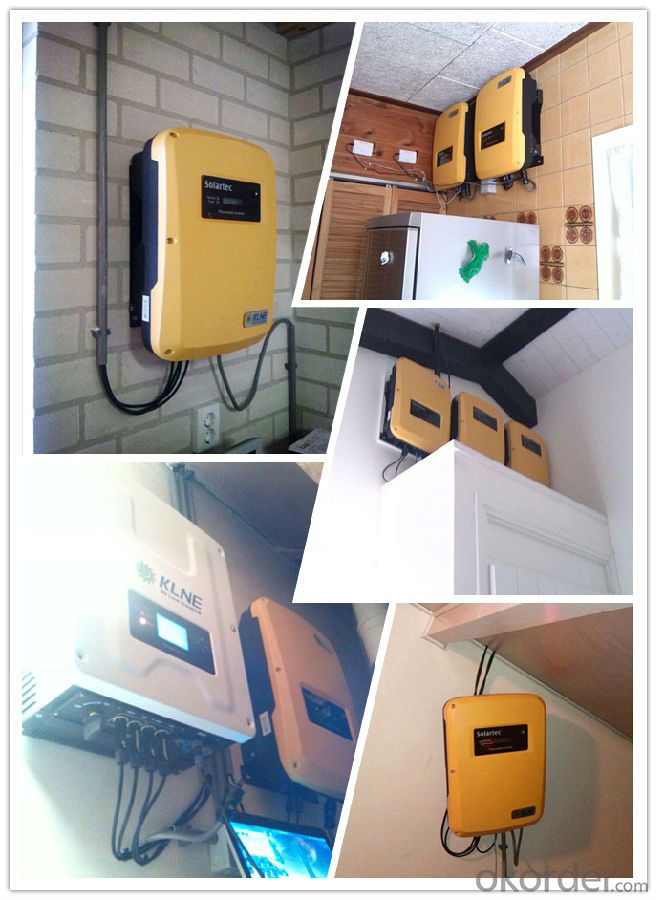Solartec D 2500 on grid 2.5-5kw solar inverter 2 MPPT WIFI
- Loading Port:
- Shanghai
- Payment Terms:
- TT OR LC
- Min Order Qty:
- -
- Supply Capability:
- 10000 set/month
OKorder Service Pledge
Quality Product, Order Online Tracking, Timely Delivery
OKorder Financial Service
Credit Rating, Credit Services, Credit Purchasing
You Might Also Like
Solartec D 2500,3000,3600,4000,4600,5000
2MPPT Trackers
online monitoring system by integrated WIFI
Integrated DC Switch
Comprehensive protection functions
Graphic display
High efficiency 97.5%
RS 485/RS 232/SolarLog Communication
5 Years warranty
G83,G59,VDE 4105,VDE 0126,CEI



- Q:Can a solar inverter be used with a solar-powered backup generator?
- Certainly, a solar-powered backup generator can indeed be utilized in conjunction with a solar inverter. The solar inverter's primary function is to convert the DC electricity generated by solar panels into AC electricity, which is suitable for powering household appliances and various electrical devices. Conversely, a solar-powered backup generator harnesses solar energy to either charge its batteries or store any surplus electricity. When the solar panels are actively generating electricity, the solar inverter will convert the DC electricity into AC electricity. This AC electricity can then be directly employed within the household or redirected back to the grid, assuming the system is interconnected. Should there be an excess of electricity being produced and the batteries of the solar-powered backup generator are fully charged, the solar inverter has the capability to divert this surplus electricity to other loads or devices. During periods when solar energy is either insufficient or unavailable, the solar-powered backup generator can seamlessly activate and provide the requisite electricity to power the house or recharge the batteries. In such cases, the solar inverter remains responsible for the conversion of the DC electricity generated by the solar-powered backup generator into AC electricity. To summarize concisely, employing a solar inverter alongside a solar-powered backup generator guarantees a continuous supply of electricity, even during instances of limited solar energy availability.
- Q:Can a solar inverter be used with solar-powered signage systems?
- Yes, a solar inverter can be used with solar-powered signage systems. A solar inverter is responsible for converting the direct current (DC) produced by the solar panels into alternating current (AC) that can be used to power electrical devices. Since solar-powered signage systems also require AC power to operate, a solar inverter is necessary to ensure compatibility and efficient energy conversion.
- Q:How do you connect solar panels to a solar inverter?
- To connect solar panels to a solar inverter, you need to follow a few steps. First, ensure that the solar panels are properly installed and positioned to receive maximum sunlight. Then, connect the positive and negative terminals of each solar panel in series or parallel, depending on the system design. Next, connect the positive and negative terminals of the solar panel array to the input terminals of the solar inverter. Finally, double-check all connections and wiring to ensure they are secure and tight.
- Q:How does a solar inverter work?
- A solar inverter works by converting the direct current (DC) electricity produced by solar panels into alternating current (AC) electricity that can be used to power household appliances and be fed into the electrical grid. It performs this conversion by using electronic components, such as transistors and capacitors, to change the voltage and frequency of the electricity. The inverter also monitors the solar panel's output and adjusts its operation to ensure optimal performance and efficiency.
- Q:Can a solar inverter be used in regions with extreme weather conditions?
- Yes, a solar inverter can be used in regions with extreme weather conditions. However, it is important to choose an inverter that is designed and rated for the specific weather conditions of that region. For example, there are solar inverters available that are built to withstand high temperatures, extreme cold, humidity, and even harsh weather events such as hurricanes. It is crucial to consider the environmental factors and select an inverter that is suitable for the specific climate conditions to ensure optimal performance and longevity.
- Q:What is the role of a maximum power point tracker (MPPT) in a solar inverter?
- The role of a maximum power point tracker (MPPT) in a solar inverter is to optimize the energy output of the solar panels by continuously adjusting the operating point to the maximum power point (MPP). It ensures that the solar panels are operating at their highest efficiency, maximizing the conversion of sunlight into usable electrical energy. This helps to extract the maximum power from the solar panels under varying environmental conditions such as shading, temperature changes, and fluctuating solar irradiance, ultimately improving the overall performance and energy yield of the solar inverter system.
- Q:Can a solar inverter be used in a net metering system?
- Yes, a solar inverter can be used in a net metering system. In fact, a solar inverter is an essential component of a net metering system as it converts the direct current (DC) electricity generated by solar panels into alternating current (AC) electricity that can be used in homes and businesses. The excess electricity generated by the solar panels is fed back into the grid through the inverter, allowing for net metering and potentially earning credits or reducing electricity bills.
- Q:Can a solar inverter be installed outdoors?
- Yes, a solar inverter can be installed outdoors. However, it is important to ensure that the inverter is designed to withstand outdoor conditions, such as rain, humidity, and temperature fluctuations. Outdoor installation should also comply with local electrical codes and regulations.
- Q:Can a solar inverter be used in a solar-powered street lighting system?
- Yes, a solar inverter can be used in a solar-powered street lighting system. A solar inverter is responsible for converting the direct current (DC) produced by solar panels into alternating current (AC) that can be used to power the street lights. Therefore, it plays a vital role in ensuring that solar energy is efficiently utilized in the lighting system.
- Q:Can a solar inverter be integrated with energy management systems?
- Yes, a solar inverter can be integrated with energy management systems. Solar inverters can be connected to energy management systems to monitor and control the generation and consumption of solar energy. This integration allows for better optimization of energy usage, real-time monitoring of solar production, and intelligent management of energy flows within a building or grid.
1. Manufacturer Overview |
|
|---|---|
| Location | |
| Year Established | |
| Annual Output Value | |
| Main Markets | |
| Company Certifications | |
2. Manufacturer Certificates |
|
|---|---|
| a) Certification Name | |
| Range | |
| Reference | |
| Validity Period | |
3. Manufacturer Capability |
|
|---|---|
| a)Trade Capacity | |
| Nearest Port | |
| Export Percentage | |
| No.of Employees in Trade Department | |
| Language Spoken: | |
| b)Factory Information | |
| Factory Size: | |
| No. of Production Lines | |
| Contract Manufacturing | |
| Product Price Range | |
Send your message to us
Solartec D 2500 on grid 2.5-5kw solar inverter 2 MPPT WIFI
- Loading Port:
- Shanghai
- Payment Terms:
- TT OR LC
- Min Order Qty:
- -
- Supply Capability:
- 10000 set/month
OKorder Service Pledge
Quality Product, Order Online Tracking, Timely Delivery
OKorder Financial Service
Credit Rating, Credit Services, Credit Purchasing
Similar products
New products
Hot products
Hot Searches
Related keywords





























